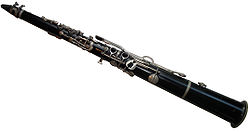Tárogató
 | |
| Other names | Töröksíp, Taragot |
|---|---|
| Classification | |
| Playing range | |
|
Written Range: B♭3 to C6 (scientific pitch notation) Note: Romanian-made instruments may have difficulty reaching the upper range. | |
| Related instruments | |
The tárogató (töröksíp, Turkish pipe; plural tárogatók or, anglicized, tárogatós; Template:Lang-ro or torogoata) refers to two different Hungarian woodwind instruments: the ancient tárogató and the modern (or modified) tárogató. The modern tárogató was intended to be a recreation of the original tárogató, but the two instruments are thought to have little in common.[1]
History
This article needs to be divided into sections. (August 2010) |
Mention of the tárogató in Hungarian writings dates back at least as long ago as the 15th century. It is not clear whether it was first brought into Europe by the Magyars when they first immigrated from the east in the 9th century. It is certain, however, that instruments of this type, descended from the Middle Eastern zurna, were introduced into Eastern Europe by the Turks in the Middle Ages, as evidenced by the term töröksip—"Turkish pipe"—which was used as a synonym for tárogató.[1] It is possible that instruments from both traditions were combined into one entity. The tárogató has a Persian origin, and it appeared in Hungary during the Turkish wars.[2] Up to about the 18th century, the tárogató was a type of shawm, with a double reed, conical bore, and no keys.
Being a very loud and raucous instrument, the tárogató was used as a signaling instrument in battle (like the bugle or the bagpipe).[1]
The instrument was eventually abandoned being considered too loud for a concert hall.[2]
Because the tárogató was an iconic instrument of the Rákóczi's War for Independence (1703–1711). Its use was suppressed in the 18th century by the Habsburg monarchy.[1][2]
In the 1890s a modern version was invented by Vencel József Schunda, a Budapest instrument maker.[2] It uses a single reed, like a clarinet or saxophone, and has a conical bore, similar to the saxophone. The instrument is made of wood, usually black grenadilla wood like a clarinet. The most common size, the soprano tárogató in B♭, is about 29 inches (74 cm) in length and has a mournful sound similar to a cross between an English horn and a soprano saxophone. Other sizes exist; one maker, János Stowasser, advertised a family of seven sizes of which the largest was a contrabass tárogató in E♭.[1] The new tárogató bears very little resemblance with the historical tárogató and the two instruments should not be confused.[1][3] It has been suggested that the name schundaphone would have been more accurate, but tárogató was used because of the nationalistic image that the original instrument had.[4]
This instrument was a symbol of Hungarian aristocracy, and the favorite woodwind instrument of Governor Miklós Horthy.[4]
Manufacturing in Hungary ceased after World War II, though tárogatós continued to be made in Romania and other countries. In the 1990s several Hungarian makers started producing the instrument again.
A modern tárogató may occasionally be heard in Act 3 of Tristan und Isolde by Richard Wagner where it has become traditional in some opera houses (e.g. the Royal Opera House, London) to use it instead of the off-stage cor anglais for the last passage (bars 999-1149) of the Shepherd's air, but Wagner did not specify this, merely suggesting in the score "a specially built simple natural instrument".
In the 1920s, Luţă Ioviţă, who played the instrument in the army during World War I, brought it to Banat (Romania), where it became very popular under the name taragot.[5]
Dumitru Fărcaş, who was born in Maramureş, made the instrument known all over the world and is considered to be the most famous tárogató player.[2][5]
See also
References
- ^ a b c d e f Fox, Stephen. "The Tárogató". Retrieved 2006-10-03.
- ^ a b c d e A Brief history of the tarogato/taragot, retrieved 04.06.2008
{{citation}}: Check date values in:|accessdate=(help) - ^ The Tárogató Page, retrieved 04.06.2008
{{citation}}: Check date values in:|accessdate=(help) - ^ a b The Tárogató and Central Eastern Europe, retrieved 04.06.2008
{{citation}}: Check date values in:|accessdate=(help) - ^ a b The taragot in Romanian folk music, retrieved 04.06.2008
{{citation}}: Check date values in:|accessdate=(help)
Tárogató makers
- Stephen Fox [1]
- Bruno Salenson [2]
